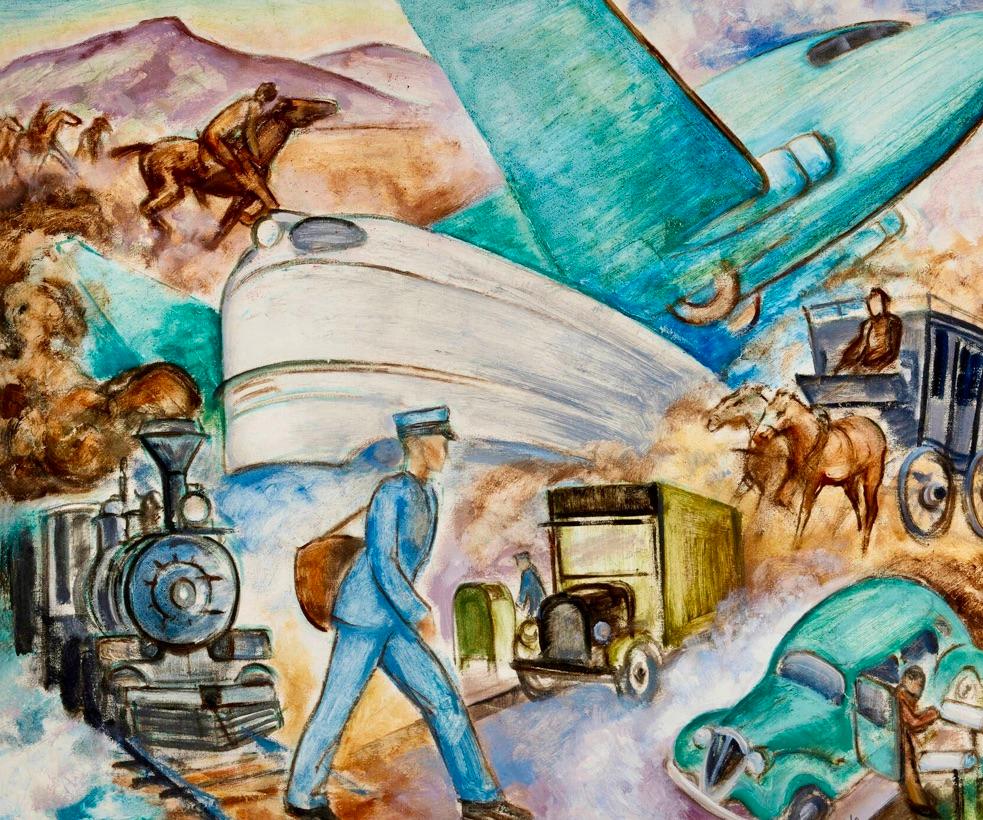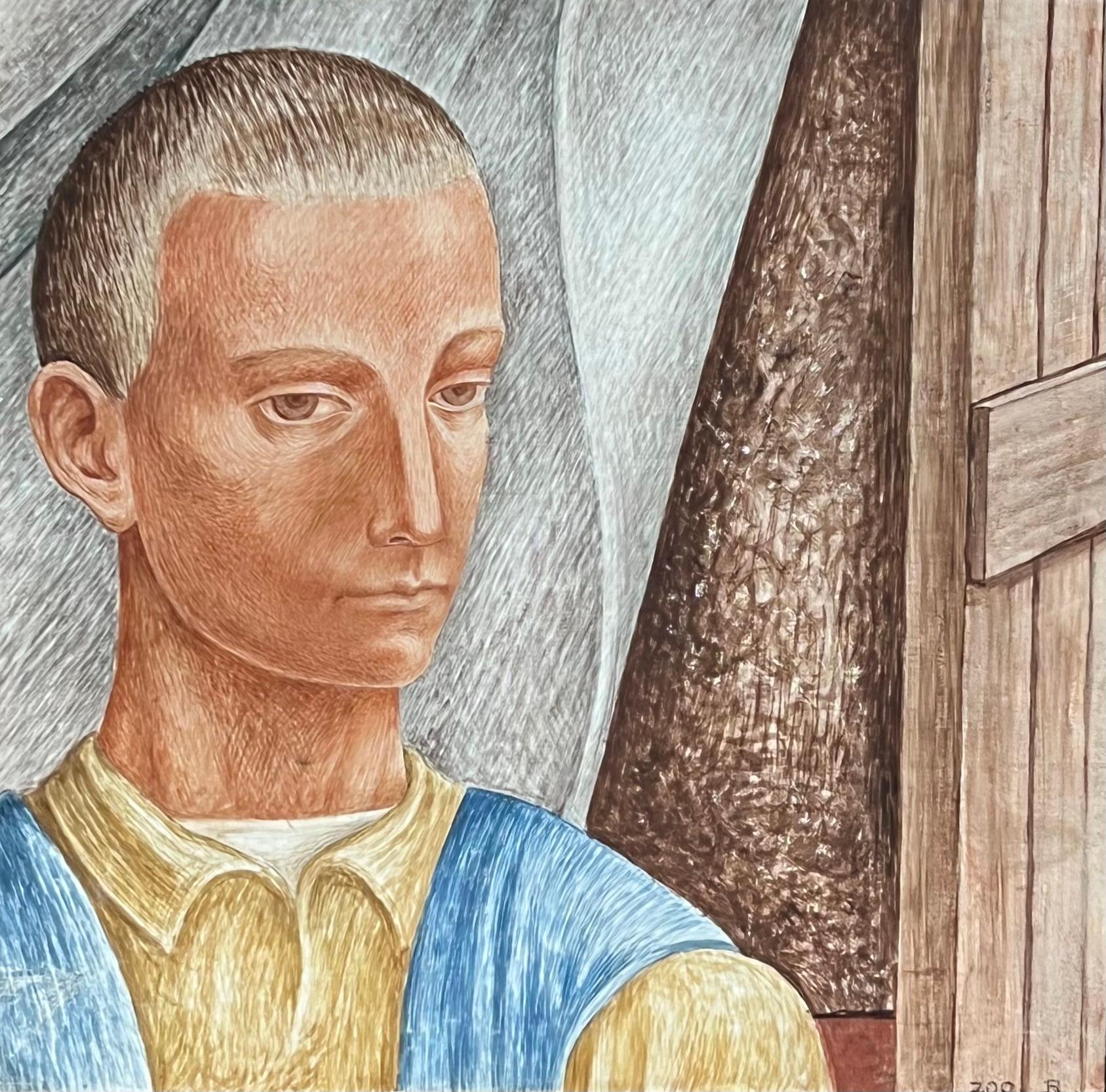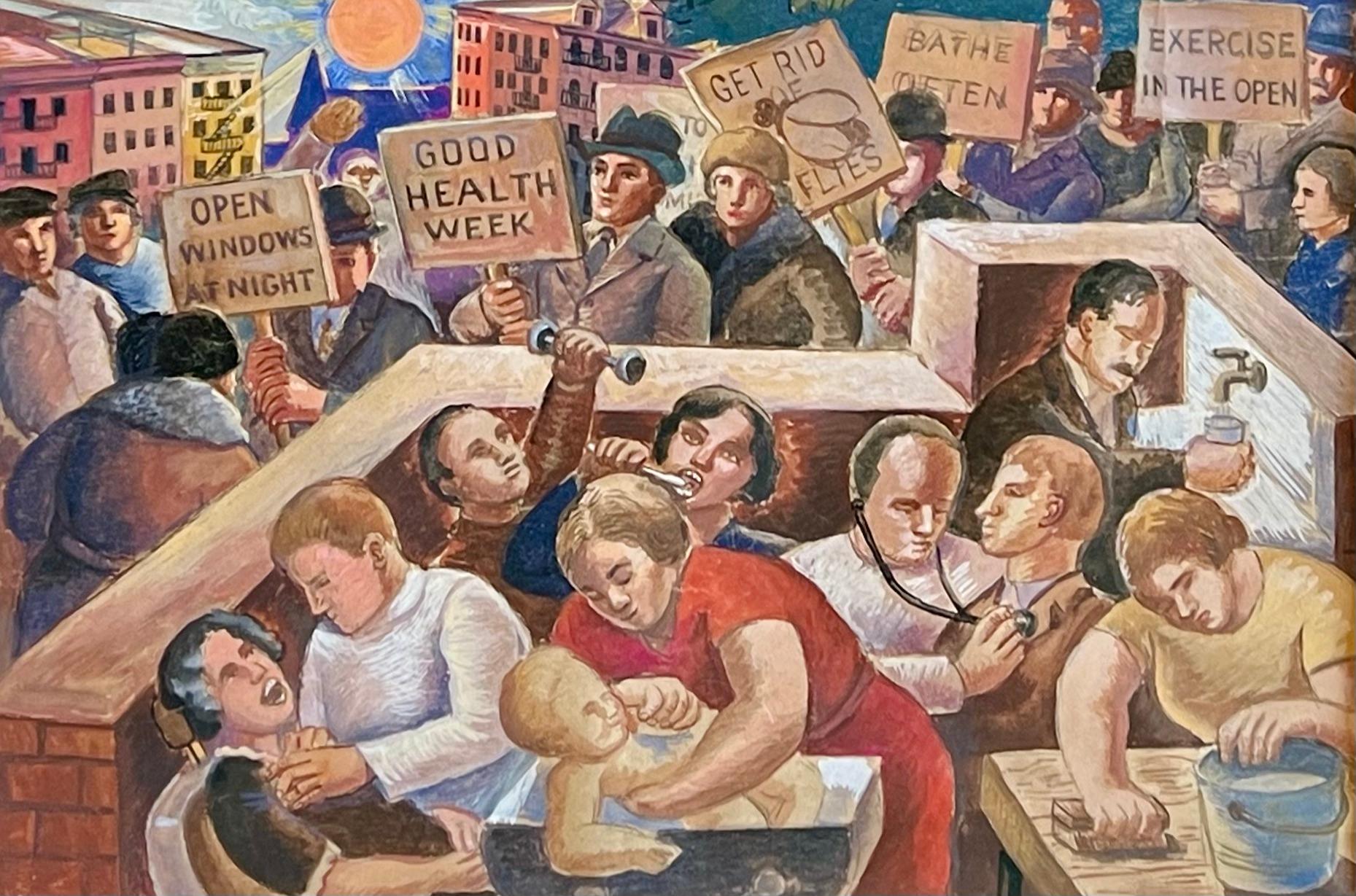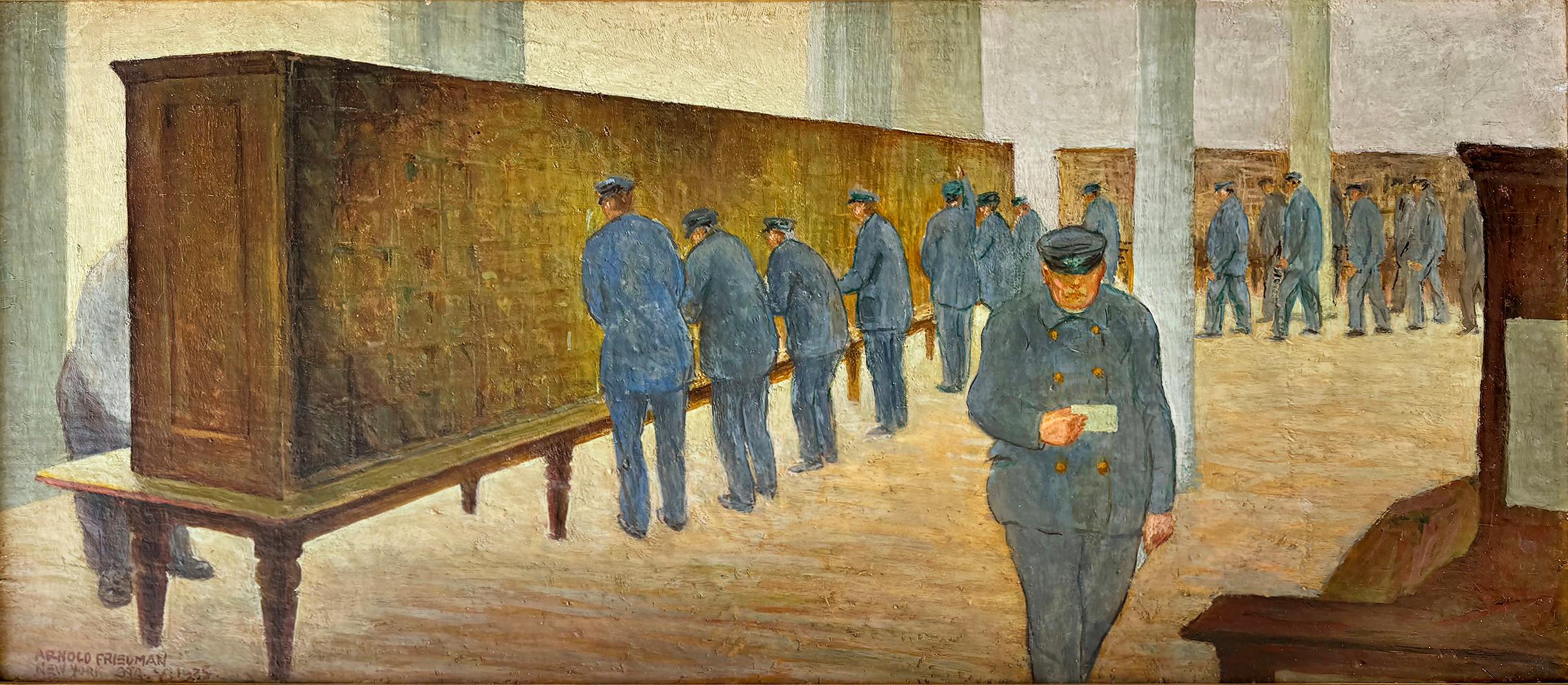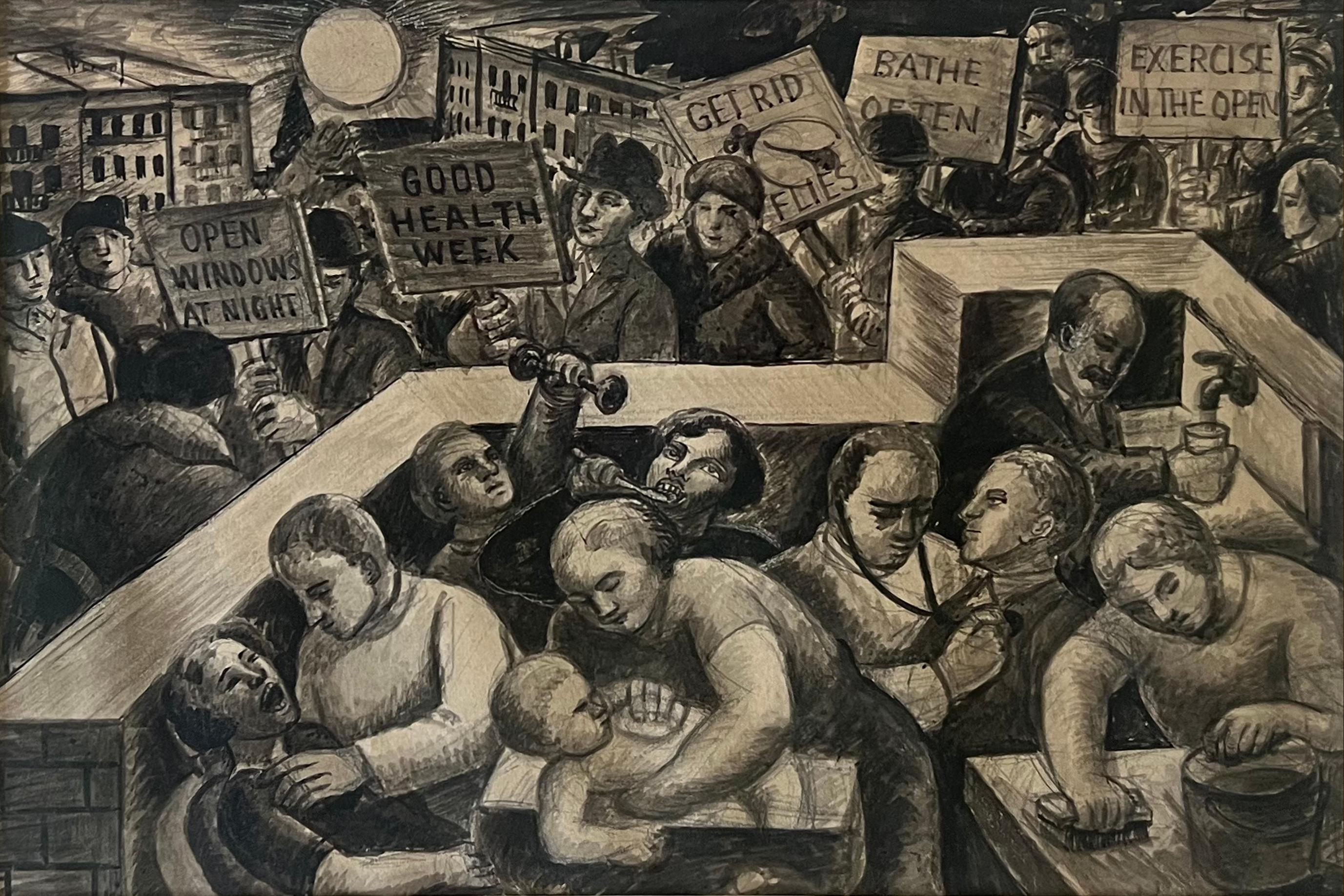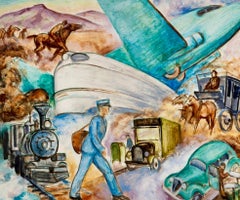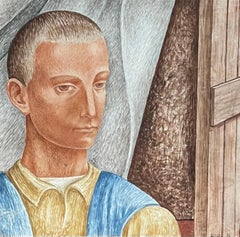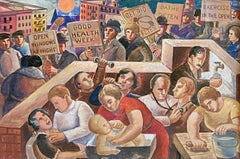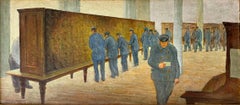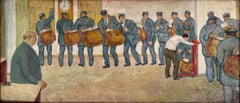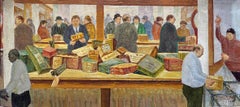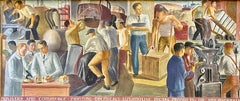Items Similar to Post Office WPA Mural Study American Scene Social Realism Modern 20th Century
Want more images or videos?
Request additional images or videos from the seller
1 of 11
Carlos LopezPost Office WPA Mural Study American Scene Social Realism Modern 20th Century1940
1940
$15,000
£11,320.09
€12,959.79
CA$21,154.97
A$23,225.52
CHF 12,116.80
MX$281,061.15
NOK 151,865.34
SEK 143,097.08
DKK 96,741.36
About the Item
Post Office WPA Mural Study American Scene Social Realism Modern 20th Century
Carlos Lopez (1910-1953)
"Bounty" WPA Mural Study for Michigan Post Office
19 ½ x 22 ½ inches
Oil on Board, 1940
Signed lower left and inscribed 'Portrait for mural at Paw Paw Mich. Post Office'
The envelope on the back of the painting is filled with papers detailing the work.
In 1940 Lopez painted a post office mural, "Bounty," in Paw Paw, Michigan. Now using a distinct illustrative style reflective of American popular culture, the mural features the rich agricultural bounty of the prosperous Michigan farming communities of Van Buren County. In the center of the mural, apples, grapes, corn, and other important crops are organized in cornucopia fashion. To the left a seemingly content migrant farm worker cares for an apple tree, while a handsome couple hold their freshly harvested bounty in baskets and look at each other with goodwill and love. On the right side of the mural a fiddler and a harmonica player make music while others dance in a celebration of the harvest.
A Michigan winter scene of ice skaters on a pond appears at the top of the mural, above the musicians, as a reminder that tourism is also a vital industry in Van Buren County, home of beautiful inland lakes, rivers, and 20 miles of Lake Michigan shoreline. This mural speaks both to the early pioneering efforts to settle and cultivate Michigan and to the modern economic wealth brought on by advanced agricultural technology. Lopez communicated a sense of plenty and well-being in a self-conscious attempt to overcome post-Depression anxiety and slow economic recovery in Michigan.
BIO
The following is courtesy of Paul Petosky, researcher of Post Office Murals in Michigan. His source is the Julian Samora Research Institute, Michigan State University, East Lansing, MI:
"Carlos Lopez: A Forgotten Michigan Painter by George Vargas, Ph.D. Austin, Texas Occasional Paper No. 56, February 1999
Sketchy historical records show the existence of a handful of Latino artists in the United States at the turn of the century. During the 1920's, 30's, and 40's, times of national prosperity and growth as well as economic depression, Latino artists increased across the country, including Michigan and the Midwest in general. Limited records show artists of Latino or Latin American origins producing visual expressions diverse in style and theme, representing folk art to mainstream influences. These artists reflected and portrayed their immediate environment as well as the broader American society. Their openness to multiple influences has continued to allow Latinos to respond to trends in American art in a unique way, further enriching the concept of artistic and cultural diversity in Latino art.
In the modern period, some Latino artists participated in the federal mural painting projects in the United States. These public art projects were directly influenced by the Mexican mural movement of the 1920's and 30's, both ideologically and aesthetically. In Michigan, despite general interest in Diego Rivera's Detroit Industry fresco cycle (1932-1933) at the Detroit Institute of Arts, Latino art generally speaking, featured less social commentary and more individual expression that encompassed a panorama of styles and aesthetics. Many Latino artists did not refer to elements of their own culture in their work, but instead leaned toward mainstream art in search of personal meaning.
Among mainstream artists working in Michigan, Cuban-born Carlos Lopez (1908 - 1953) was one of the most recognized modern painters in the United States. During his lifetime, he received many prestigious awards and commissions. An academically trained landscape and portrait painter, Lopez serves as a vital historical link connecting American modern art in Michigan with a new Latino history of the state.
As one of only several Michigan artists, Latino or otherwise, who received federal mural commissions, Lopez also made important contributions to the development of American mural art through his historical murals in Michigan and Illinois. The work of Lopez offers insight into the cultural history of the Latino presence in Michigan, as well as giving us a unique view of popular culture in the United States.
For 20 years Lopez played an influential role in the artistic life of Ann Arbor and Detroit as a hardworking art teacher, productive artist, and dedicated American, but today he still remains for the general public a shadowy figure in Michigan history.
...
One of the most famous and prolific Latino artists of the 1940's, Carlos Lopez was born in Havana, Cuba in 1908 to Spanish parents. He spent his early years in Spain, emigrating to the United States with his parents when he was 11, where he received an American art education. A versatile of exceptional quality, Lopez painted his beloved Michigan and adopted country in modern terms, representing the new spirit of American art of the times through his artworks and teaching.
Lopez first studied with George Rich at the Detroit Art Academy and later with Charles St. Pierre at the Chicago Art Institute. He also studied under Leon Makielski, landscape and portrait painter, and University of Michigan art teacher. Lopez exhibited for the first time in Detroit in January 1932; soon after he served as director of the Detroit Art Academy from 1933 to 1937 and later as a teacher at the Meinzinger School of Art in Detroit from 1937 to 1942. Following a brief tenure as an instructor at the Summer School of Painting in Saugatuck, Mich., in 1944, Lopez finally became a professor of art at the University of Michigan in 1945, living in Ann Arbor until his death in 1953.
A master of oils and watercolors, he often competed in the Michigan Artists Exhibition and won a number of major awards, including the Scarab Club Gold Medal in 1938 for his painting, Boy with Bow, a study of a serious and pensive youth drawing back the string on his wooden bow. He entered Boy with Bow in Springfield, Ill., at the Old Northwest Territory Art Exhibition and was awarded a cash prize. In 1936, he was a prize winner in the Michigan Artists Exhibition for his entry, Boy on a Horse, which depicts a small farm boy riding on the back of a huge work horse. Lopez vested whimsy and compassion into this familiar rural subject.
Lopez entered many state and national shows, winning more awards and critical recognition. Local awards include the Haan Prize in 1936, the Modern Art Prize in 1937, the Scarab Gold Medal in 1938, and the Kahn Award in 1940. He was featured in Detroit area exhibitions at the Detroit Institute of Arts, the Detroit Scarab Club, and the Detroit Artists' Market during this early period in his career. He also exhibited in the Golden State Exposition in 1936 and the World's Fair in New York in 1939.
Using a strong, formal sense of composition and both rich and low tonality of color, Lopez began painting murals in the late 1930's. Between 1937 and 1942, he won important mural competitions and was commissioned to create murals for post office buildings under the Treasury Department Public Works of Art Project. In 1937, assisted by his wife, Rhoda, he painted a fresco mural titled The Stage of Dawn in the post office in Dwight, Illinois, which documented the role of the stage coach in frontier transportation and mail delivery (a popular theme for post office murals tailored for the post office construction boom of the 1930's). Armed frontiersmen assist the stagecoach driver as he harnesses the frisky horses to the coach in the early morning light.
- Creator:Carlos Lopez (American)
- Creation Year:1940
- Dimensions:Height: 25 in (63.5 cm)Width: 28 in (71.12 cm)
- Medium:
- Movement & Style:
- Period:
- Condition:
- Gallery Location:New York, NY
- Reference Number:1stDibs: LU1156214153192
About the Seller
5.0
Gold Seller
Premium sellers maintaining a 4.3+ rating and 24-hour response times
Established in 2008
1stDibs seller since 2019
195 sales on 1stDibs
Typical response time: <1 hour
- ShippingRetrieving quote...Shipping from: Pawling, NY
- Return Policy
Authenticity Guarantee
In the unlikely event there’s an issue with an item’s authenticity, contact us within 1 year for a full refund. DetailsMoney-Back Guarantee
If your item is not as described, is damaged in transit, or does not arrive, contact us within 7 days for a full refund. Details24-Hour Cancellation
You have a 24-hour grace period in which to reconsider your purchase, with no questions asked.Vetted Professional Sellers
Our world-class sellers must adhere to strict standards for service and quality, maintaining the integrity of our listings.Price-Match Guarantee
If you find that a seller listed the same item for a lower price elsewhere, we’ll match it.Trusted Global Delivery
Our best-in-class carrier network provides specialized shipping options worldwide, including custom delivery.More From This Seller
View All"History of US Postal Service" American Scene Social Realism WPA Modern Chicago
By Harold Haydon
Located in New York, NY
"History of US Postal Service" American Scene Social Realism WPA Modern Chicago
Harold Haydon
"History of the U.S. Postal Service"
21 x 25 1/2 inches
O...
Category
1930s American Modern Figurative Paintings
Materials
Canvas, Oil
WPA Post Office Mural Study American Scene Regionalism Social Realism Modern Art
By Louise Ronnebeck
Located in New York, NY
WPA Post Office Mural Study American Scene Regionalism Social Realism Modern Art
Louise Emerson Ronnebeck (1901 - 1980)
Oil Riggers, Mural Study
Image: 6 1/2 x 37 inches
Watercolor ...
Category
1930s American Modern Figurative Drawings and Watercolors
Materials
Watercolor, Cardboard, Paper
WPA Mural Study 1940 American Scene Modern Social Realism Figurative Mid Century
By Michael Loew
Located in New York, NY
WPA Mural Study 1940 American Scene Modern Social Realism Figurative Mid Century
Michael Loew (1907-1985)
Detail for Mural (Social Security Building Washington D.C.)
24 x 24 inches ...
Category
1940s American Realist Figurative Paintings
Materials
Canvas, Oil
"Good Health Week" WPA American Scene Mid 20th Century Modern Social Realism
By Jo Cain
Located in New York, NY
"Good Health Week" WPA American Scene Mid 20th Century Modern Social Realism
Jo Cain (1904 – 2003)
Good Health Week
10 ½ x 15 1/2 inches
Oil on pape...
Category
1940s American Realist Figurative Drawings and Watercolors
Materials
Paper, Oil
"Good Health Week" American Scene Modern Social Realism Mid 20th Century WPA Era
By Jo Cain
Located in New York, NY
"Good Health Week" American Scene Modern Social Realism Mid- 20th Century WPA Era
Jo Cain (1904 – 2003)
Good Health Week – b/w
10 ½ x 15 1/2 inches
I...
Category
1930s American Realist Figurative Drawings and Watercolors
Materials
Paper, Ink
WPA Mural Study Mid-Century Modern American Scene Social Realism Workers
By Anton Refregier
Located in New York, NY
WPA Mural Study Mid-Century Modern American Scene Social Realism Workers
Anton Refregier (1905-1979)
Mural Study, Untitled
7 ¾ x 22 inches (sight)
Gouache, pencil, and charcoal on board, c. 1940s
Unsigned
Provenance: Estate of Seymour Fogel, noted verso
Thomas McCormick Gallery...
Category
1940s American Modern Mixed Media
Materials
Charcoal, Gouache, Board, Pencil
You May Also Like
American Scene Depression Era New York City Post Office
By Arnold Friedman
Located in Miami, FL
This is a painting about a man who travels back into the past and engages with a different stage in his life.
Arnold Friedman worked at the New York City Post Office for four decades...
Category
1930s American Realist Figurative Paintings
Materials
Oil, Wood Panel
Depression Era New York City - Journey Back in Time - American Scene Painting
By Arnold Friedman
Located in Miami, FL
This is a painting about a man who travels back into the past and engages with a different stage in his life.
Arnold Friedman worked at the New York City Post Office for four decades...
Category
1930s American Realist Figurative Paintings
Materials
Oil, Wood Panel
Post Office Parcel Post Window - Depression Era
By Arnold Friedman
Located in Miami, FL
Arnold Friedman worked as a clerk for decades at the Station Y, the branch at 3rd Avenue and East 67th Street in New York City. This present work was done two years after his retirem...
Category
1930s American Realist Figurative Paintings
Materials
Oil, Wood Panel
Industry and Commerce
Located in Los Angeles, CA
This mural study is part of our exhibition America Coast to Coast: Artists of the 1930s
Industry and Commerce, 1936, tempera on panel, 16 ½ x 39 ½ inches, signed verso “John Ballator, Portland Ore.” provenance includes: J.C. Penney Company, represented by Russell Tether Fine Arts Assoc.; presented in a newer wood frame
About the Painting
Industry and Commerce is a prime example of WPA Era muralism. Like a Mediaeval alter, this mural study is filled with icons, but the images of saints and martyrs are replaced with symbols of America's gospel of prosperity through capitalism. Industry and Commerce has a strong narrative quality with vignettes filling the entire surface. Extraction, logistics, design, power generation, and manufacturing for printing, chemicals, automobiles and metal products are all represented. To eliminate any doubt about the mural's themes, Ballator letters a description into the bottom of the study. Ballator also presents an idealized version of industrial cooperation, as his workers, lab-coated technicians and tie-wearing managers work harmoniously toward a common goal in the tidy and neatly designed environments. Although far from the reality of most industrial spaces, Ballator's study reflects the idealized and morale boosting tone that many mural projects adopted during the Great Depression.
About the Artist
John R Ballator achieved success as a muralist, lithographer, and teacher during the Great Depression. Born in Oregon, he studied at the Portland Museum Art School, the University of Oregon and at Yale University where he received a Bachelor of Fine Art. In 1936, Ballator was commissioned to paint a mural panel for the new Department of Justice Building in Washington DC, an important project that spanned five years with several dozen artists contributing a total of sixty-eight designs. Ballator completed murals for the St. Johns Post Office and Franklin High School, both in Portland, Oregon. He also contributed to the 1938 murals at Nathan Hale School in New Haven, Connecticut. During the late 1930s, Ballator taught art for several years at Washburn College in Topeka, Kanas, where he completed a mural for the Menninger Arts & Craft Shop before accepting a professorship at Hollins College...
Category
1930s American Realist Figurative Paintings
Materials
Tempera
Farm Tragedy (Untitled)
Located in Los Angeles, CA
Farm Tragedy (Untitled), c. 1930s, mixed media on plaster on panel, unsigned, 22 1/8 x 32 inches; label verso reads: "New York Artists Equity Association, New York, NY," provenance i...
Category
1930s American Modern Figurative Paintings
Materials
Mixed Media
San Pedro Post Office: History of Writing Mural South, Preliminary Mural Study
Located in Los Angeles, CA
This mural study is part of our exhibition America Coast to Coast: Artists of the 1930s
San Pedro Post Office: History of Writing Mural South, Preliminary Mural Maquette right panel...
Category
1930s American Modern Figurative Paintings
Materials
Mixed Media
